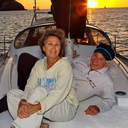0 Likes
Farshad was born in 1974 in Kermanshah and graduated from Tehran University of Arts with a bachelor's degree in cinema. Bariye is the second solo exhibition of Farshad Nekoomanesh in Shirin Gallery.
As the artist says about this exhibition:
Dastgah-e Mahur in Iranian traditional music is similar to a Major step in classical music in terms of distances and is considered happy in terms of feeling. Therefore, there are many happy parts in this Dastgah. Its roots attribute to the Maqams of ancient Iranian music, especially the Maqam of Oshaq.
The Maqam of Bariye between the Maqams of Tanbur and Hoore is undoubtedly one of the most melancholy. Its linguistic origin is from immigration (the irony of death) and is an attribute to Barbad.
The Mahour collection, part of which exhibited at the Zooran Exhibition in the spring of 2018, has now, in a two-year process, directly led to an array of Bariye. This new production may derive from the dark atmosphere of these two years.
The German painter Matthias Illner says about Nekoomanesh's artworks: "Sometimes the silence of an interior or a landscape...
I know very little about Farshad Nekoomanesh. He is a painter in Iran. His self-portrait shows him writing and sitting on a carpet. But, to be precise, one cannot find an actual facial expression that could reveal something about his character or feelings.
Farshad's early portraits are like dark menacing faces in a carpet pattern. So when you wake up from a gloomy, fear-filled dream, you discover demons in your apartment—threatening and ugly expressions that look at me, contrasted by pictures of lovers in nature. Music-making men and women, pictures painted in light colors and that seem like a fairy tale. Unreal. Fairy tales in a painting style show the pure colors and next to each other like a woodcut. As in a puzzle, I, as the viewer, have to assemble the picture in my head to recognize its motif. Different, if painted in the same style, the images of wrestling matches between men.
Some landscapes and interiors seem like silent moments between the moving images. They allow me a break from the moving impressions of his figurative."
...





Overview and HistoryTehran is the capital of Iran and the largest city in the Middle East, with a population of fifteen million people living under the peaks of the Alborz mountain range.Although archaeological evidence places human activity around Tehran back into the years 6000BC, the city was not mentioned in any writings until much later, in the thirteenth century. It's a relatively new city by Iranian standards.But Tehran was a well-known village in the ninth century. It grew rapidly when its neighboring city, Rhages, was destroyed by Mongolian raiders. Many people fled to Tehran.In the seventeenth century Tehran became home to the rulers of the Safavid Dynasty. This is the period when the wall around the city was first constructed. Tehran became the capital of Iran in 1795 and amazingly fast growth followed over the next two hundred years.The recent history of Tehran saw construction of apartment complexes and wide avenues in place of the old Persian gardens, to the detriment of the city's cultural history.The city at present is laid out in two general parts. Northern Tehran is more cosmopolitan and expensive, southern Tehran is cheaper and gets the name "downtown."Getting ThereMehrabad airport is the original one which is currently in the process of being replaced by Imam Khomeini International Airport. The new one is farther away from the city but it now receives all the international traffic, so allow an extra hour to get there or back.TransportationTehran driving can be a wild free-for-all like some South American cities, so get ready for shared taxis, confusing bus routes and a brand new shiny metro system to make it all better. To be fair, there is a great highway system here.The metro has four lines, tickets cost 2000IR, and they have segregated cars. The women-only carriages are the last two at the end, FYI.Taxis come in two flavors, shared and private. Private taxis are more expensive but easier to manage for the visiting traveler. Tehran has a mean rush hour starting at seven AM and lasting until 8PM in its evening version. Solution? Motorcycle taxis! They cut through the traffic and any spare nerves you might have left.People and CultureMore than sixty percent of Tehranis were born outside of the city, making it as ethnically and linguistically diverse as the country itself. Tehran is the most secular and liberal city in Iran and as such it attracts students from all over the country.Things to do, RecommendationsTake the metro to the Tehran Bazaar at the stop "Panzda Gordad". There you can find anything and everything -- shoes, clothes, food, gold, machines and more. Just for the sight of it alone you should take a trip there.If you like being outside, go to Darband and drink tea in a traditional setting. Tehranis love a good picnic and there are plenty of parks to enjoy. Try Mellat park on a friday (fridays are public holidays), or maybe Park Daneshjou, Saaii or Jamshidieh.Remember to go upstairs and have a look around, always always always! The Azadi Tower should fit the bill; it was constructed to commemorate the 2500th anniversary of the Persian Empire.Tehran is also full of museums such as:the Contemporary Art Museumthe Abghine Musuem (glass works)the 19th century Golestan Royal Palace museumthe museum of carpets (!!!)Reza Abbasi Museum of extraordinary miniaturesand most stunning of all,the Crown Jewels Museum which holds the largest pink diamond in the world and many other jaw-dropping jewels.Text by Steve Smith.